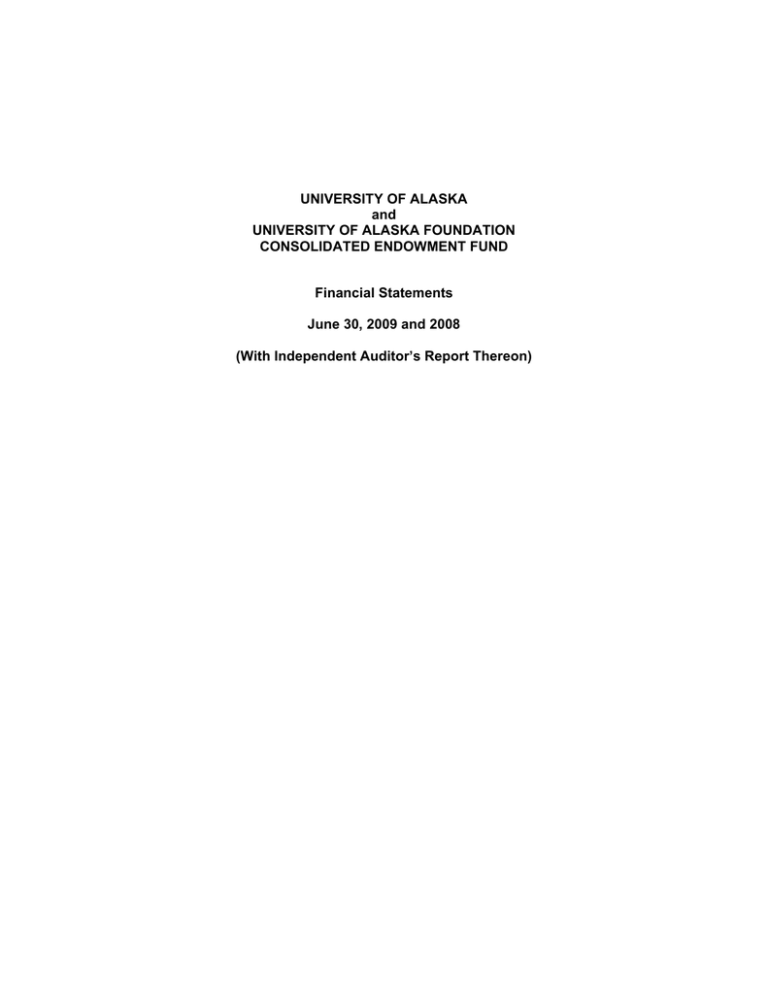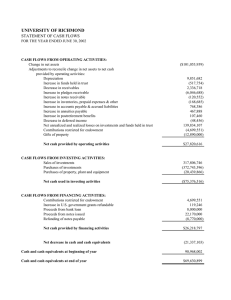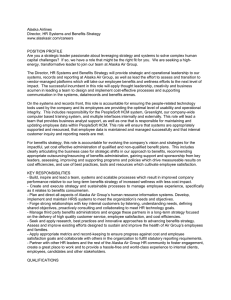UNIVERSITY OF ALASKA and UNIVERSITY OF ALASKA FOUNDATION
advertisement

UNIVERSITY OF ALASKA and UNIVERSITY OF ALASKA FOUNDATION CONSOLIDATED ENDOWMENT FUND Financial Statements June 30, 2009 and 2008 (With Independent Auditor’s Report Thereon) UNIVERSITY OF ALASKA and UNIVERSITY OF ALASKA FOUNDATION CONSOLIDATED ENDOWMENT FUND TABLE OF CONTENTS Page Statements of Assets and Liabilities 1 Statements of Operations and Changes in Net Assets 2 Statements of Cash Flows 3 Notes to Financial Statements 4 KPMG LLP Suite 600 701 West Eighth Avenue Anchorage, AK 99501 Independent Auditors' Report The Board of Trustees University of Alaska and University of Alaska Foundation Consolidated Endowment Fund: We have audited the accompanying statements of assets and liabilities of the University of Alaska and University of Alaska Foundation Consolidated Endowment Fund as of June 30, 2009 and 2008, and the related statements of operations and changes in net assets and cash flows for the years then ended. These financial statements are the responsibility of the University of Alaska and University of Alaska Foundation Consolidated Endowment Fund's management. Our responsibility is to express an opinion on these financial statements based on our audits. We conducted our audits in accordance with auditing standards generally accepted in the United States of America. These standards require that we plan and perform the audits to obtain reasonable assurance about whether the financial statements are free of material misstatement. An audit includes consideration of internal control over financial reporting as a basis for designing audit procedures that are appropriate in the circumstances, but not for the purpose of expressing an opinion on the effectiveness of the Fund's internal control over financial reporting. Accordingly, we express no such opinion. An audit also includes examining, on a test basis, evidence supporting the amounts and disclosures in the financial statements, assessing the accounting principles used and significant estimates made by management, as well as evaluating the overall financial statement presentation. We believe that our audits provide a reasonable basis for our opinion. In our opinion, the financial statements referred to above present fairly, in all material respects, the financial position of the University of Alaska and University of Alaska Foundation Consolidated Endowment Fund at June 30, 2009 and 2008, and the changes in its net assets and cash flows for the years then ended, in conformity with U.S. generally accepted accounting principles. December 15, 2009 KPMG LLP, a U.S. limited liability partnership, is the U.S. member firm of KPMG International, a Swiss cooperative. UNIVERSITY OF ALASKA and UNIVERSITY OF ALASKA FOUNDATION CONSOLIDATED ENDOWMENT FUND STATEMENTS OF ASSETS AND LIABILITIES June 30, 2009 and 2008 2009 Assets Cash and cash equivalents Fixed income securities Equity securities Alternative investments Real estate partnerships and investment trusts Other investments Interest and dividends receivable $ Total assets 2008 23,851,939 36,680,276 79,449,850 52,316,633 6,049,368 198,348,066 Liabilities - $ 6,255 56,269,967 114,187,940 74,218,437 12,811,410 1,776,243 22,433 259,292,685 - Net Assets University of Alaska University of Alaska Foundation Total net assets 108,861,995 89,486,071 143,071,174 116,221,511 $ 198,348,066 $ 259,292,685 $188.10 Net Asset Value Per Unit The accompanying notes are an integral part of the financial statements 1 $251.89 UNIVERSITY OF ALASKA and UNIVERSITY OF ALASKA FOUNDATION CONSOLIDATED ENDOWMENT FUND STATEMENTS OF OPERATIONS AND CHANGES IN NET ASSETS For the years ended June 30, 2009 and 2008 Investment Income 2009 Interest and dividend income Operating losses from alternative investments Other investment income $ Net investment income before expenses 3,440,598 (390,375) - 2008 $ 4,499,772 (199,099) 201,627 3,050,223 4,502,300 182,656 53,106 1,061 21,349 366,013 50,000 17,521 9,699 258,172 443,233 2,792,051 4,059,067 (63,860,375) (13,047,254) (61,068,324) (8,988,187) (8,358,942) (1,936,501) 10,419,148 (7,321,197) (1,293,555) 10,351,674 Net Decrease in Net Assets (60,944,619) (7,251,265) Net assets, beginning of year 259,292,685 Expenses Management fees Investment consulting fees Custodial fees Audit fees Total expenses Net investment income Realized and Unrealized Investment Losses Net realized and unrealized investment losses Net Decrease in Net Assets Resulting from Operations Distributions for endowment spending Distributions for endowment assessments Additional investments Net assets, end of year $ 198,348,066 The accompanying notes are an integral part of the financial statements 2 266,543,950 $ 259,292,685 UNIVERSITY OF ALASKA and UNIVERSITY OF ALASKA FOUNDATION CONSOLIDATED ENDOWMENT FUND STATEMENTS OF CASH FLOWS For the years ended June 30, 2009 and 2008 Cash flows from operating activities: 2009 Net decrease in net assets from operations Adjustments to reconcile net decrease in net assets resulting from operations to net cash provided by (used in) operating activities: Purchases of investments Proceeds from distributions or sale of investments Net realized and unrealized loss on investments Decrease in interest and dividends receivable $ Net cash provided by (used in) operating activities 2008 (61,068,324) $ (8,988,187) (14,332,583) 35,240,078 63,860,375 22,432 (99,268,010) 93,395,795 13,047,254 81,812 23,721,978 (1,731,336) 10,419,148 (8,358,941) (1,936,501) 10,351,674 (7,321,197) (1,293,555) Cash flows from financing activities: Additions Spending distributions Endowment assessments Net cash provided by (used in) financing activities Net increase in cash and cash equivalents Cash and cash equivalents, beginning of year Cash and cash equivalents, end of year $ 123,706 1,736,922 23,845,684 5,586 6,255 669 23,851,939 The accompanying notes are an integral part of the financial statements 3 $ 6,255 UNIVERSITY OF ALASKA and UNIVERSITY OF ALASKA FOUNDATION CONSOLIDATED ENDOWMENT FUND NOTES TO FINANCIAL STATEMENTS June 30, 2009 and 2008 1. Organization The Consolidated Endowment Fund (fund) was established July 1, 1997 to combine, for investment purposes, certain assets of the University of Alaska (university) Land-Grant Endowments and the University of Alaska Foundation (foundation) Pooled Endowment Fund. The fund is managed by the foundation through its investment committee and treasurer. The university’s Land-Grant Endowments consist of the Endowment Trust Fund, which is codified in Alaska Statute 14.40.400, and its companion Inflation-Proofing Fund. The source of the funding consists of income from the sale or lease of land granted to the university by an Act of Congress approved January 21, 1929, other gifts and bequests and funds dedicated to the purposes of the Endowment Trust Fund by the Board of Regents. The Foundation Pooled Endowment Fund includes endowment and similar funds contributed to the foundation that do not have specific investment restrictions. Earnings from the Pooled Endowment Fund are for the support of the university, subject to donor imposed restrictions. Investments of the fund may be held in the name of the foundation, the university, the fund, or any fund or nominee as may be authorized by the foundation’s treasurer. In preparing the financial statements, management is required to make estimates that affect the reported amounts of assets and liabilities and disclosures of contingent assets and liabilities as of the date of the statements of assets and liabilities and operations for the period. Actual results may differ from those estimates and those differences could be material. The more significant accounting and reporting policies and estimates applied in the preparation of the accompanying financial statements are discussed below. 2. Summary of Significant Accounting Policies The financial statements are prepared using the accrual basis of accounting. Due to the endowment nature of the fund, all assets, including cash and cash equivalents, are considered non-current assets held for long-term investment. Cash and cash equivalents include highly liquid short-term investments including an overnight repurchase agreement and a money market account that invests in short-term US Treasury securities. The fund is managed under the “total return” concept of investment management intended to preserve and maintain the purchasing power of the principal. This approach emphasizes total investment return - traditional yield or investment income, and net realized and unrealized gains and losses. The fund uses a unitized system to account for each participant’s interest. Contributions to and withdrawals from the fund result in an increase or decrease in the number of units owned and are based on the unit value at the beginning of the month in which the contribution or withdrawal is made. Large additions to the fund are initially invested in cash and cash equivalents and dollar – cost-averaged into the investment pool over a ten month period. Investment income, fees and realized and unrealized gains and losses are allocated monthly to participating funds on a per unit basis. Investment income net of fees increases the number of units outstanding, while realized and unrealized gains and losses affect the per unit value. 4 UNIVERSITY OF ALASKA and UNIVERSITY OF ALASKA FOUNDATION CONSOLIDATED ENDOWMENT FUND NOTES TO FINANCIAL STATEMENTS June 30, 2009 and 2008 2. Summary of Significant Accounting Policies, continued Valuation Investments in fixed income and equity marketable securities are stated at fair value based on quoted market prices. Investments in private partnership interests are valued at fair value, as determined in good faith by the general partner. The general partner’s evaluation of fair value is based upon the most recent available financial information provided to the partnership, adjusted by amounts necessary to reflect the fair value of the investment at the measurement date, if any. The fair value of each partnership does not necessarily represent the amounts that may ultimately be realized since such amounts depend upon future circumstances that cannot reasonably be determined until the investment is actually liquidated. Real estate partnerships and funds are valued based on appraisals of properties held and conducted by third-party appraisers retained by the general partner or investment manager. General partners of marketable alternatives provide values based on quoted market prices and exchange rates for publicly held securities and valuation estimates of derivative instruments. General partners of oil and gas partnerships use third-party appraisers to value properties. Valuations provided by the general partners and investment managers are evaluated by management and management believes such values are reasonable at June 30, 2009. The net realized and unrealized appreciation (depreciation) in fair value of investments is reflected in the statement of operations. Fair value estimates are made at a point in time, based on relevant market data as well as the best information available about the financial instrument. Fair value estimates for financial instruments for which no or limited observable market data is available are based on judgments regarding current economic conditions, liquidity discounts, currency, credit and interest rate risks, loss experience and other factors. These estimates involve significant uncertainties and judgments and cannot be determined with precision. As a result, such calculated fair value estimates may not be realizable in a current sale or immediate settlement of the instrument. In addition, changes in the underlying assumptions used in the fair value measurement technique, including discount rates, liquidity risks, and estimates of future cash flows, could significantly affect these fair value estimates. Because of the inherent uncertainty of valuation, this estimated value may differ from the value that would have been used had a ready market for these investments existed, and the differences could be material. Fair Value Measurement Effective July 1, 2008, the fund adopted Statement of Financial Accounting Standards No. 157, Fair Value Measurements (FAS 157). This standard clarifies the definition of fair value for financial reporting, establishes a hierarchal disclosure framework for measuring fair value and requires additional disclosures about the use of fair value measurements. The hierarchy established under FAS 157 requires the classification of the fund’s investments into three levels, based on the lowest level of input that is significant to each fair value measurement. The FAS 157 hierarchy gives the highest priority to unadjusted quoted prices in active markets for identical assets or liabilities (Level 1) and the lowest priority to unobservable inputs (Level 3). The three levels of the fair value hierarchy under FAS 157 are described below: Level 1 – Unadjusted quoted prices in active markets that are accessible at the measurement date for identical assets or liabilities. 5 UNIVERSITY OF ALASKA and UNIVERSITY OF ALASKA FOUNDATION CONSOLIDATED ENDOWMENT FUND NOTES TO FINANCIAL STATEMENTS June 30, 2009 and 2008 2. Summary of Significant Accounting Policies, continued Level 2 – Quoted prices for similar assets or liabilities, or inputs that are observable, either directly or indirectly, in markets that are either active or inactive. This includes alternative investments valued at net asset value or equivalent in accordance with FAS 157-g. Level 3 – Pricing inputs are unobservable for the asset or liability and are based on the fund’s own assumptions about the assumptions that market participants would use in pricing the asset or liability. Level 3 includes investments that are supported by little or no market activity. A financial instrument’s level within the fair value hierarchy is based on the lowest level of any input that is significant to the fair value measurement. The inputs or methodology used for valuing investments are not necessarily an indication of the risk associated with investing in those investments. The following table presents the investments carried on the Statement of Assets and Liabilities by caption and by level within the valuation hierarchy as of June 30, 2009. Level 1 Fixed income Equity securities Alternative investments Real estate $ Total $ Level 2 - $ - $ Level 3 35,708,073 79,449,850 17,008,244 1,675,967 $ 133,842,134 $ 972,203 Total $ 36,680,276 79,449,850 52,316,633 6,049,368 $ 174,496,127 35,308,389 4,373,401 40,653,993 The following table includes a rollforward of the amounts for the year ended June 30, 2009 for investments classified within Level 3. Balance, July 1, 2008 Additions Withdrawals Net investment losses included in Investment Income Net realized gain Net change in unrealized loss $ 64,791,237 11,601,865 (17,926,672) (316,445) 367,025 (17,863,017) Balance, June 30, 2009 $ 40,653,993 All net realized and unrealized gains and losses in the table above are reflected in the accompanying Statement of Operations and Changes in Net Assets in net realized and unrealized investment losses and relate to investments still held at the reporting date. Effective June 30, 2009, the fund elected to apply the concepts of the proposed FASB Staff Position No. FAS 157-g, Estimating the Fair Value of Investments in Investment Companies That Have Calculated Net Asset Value per Share in Accordance with the AICPA Audit and Accounting Guide, Investment Companies, to its alternative investments including hedge funds, private equity funds, real estate funds, venture capital funds and fund of funds. The guidance amends 6 UNIVERSITY OF ALASKA and UNIVERSITY OF ALASKA FOUNDATION CONSOLIDATED ENDOWMENT FUND NOTES TO FINANCIAL STATEMENTS June 30, 2009 and 2008 2. Summary of Significant Accounting Policies, continued FAS 157 and permits, as a practical expedient, fair value of investments within its scope to be estimated using net asset value (NAV) or its equivalent. The NAV reported by each fund is used as a practical expedient to estimate the fair value of the fund’s interest therein and its classification in Level 2 or 3 is based on the fund’s ability to redeem its interest at or near the date of the Statement of Assets and Liabilities. If the interest can be redeemed in the near term, the investment is classified in Level 2. The classification of investments in the fair value hierarchy is not necessarily an indication of the risks, liquidity, or degree of difficulty in estimating the fair value of each investment’s underlying assets and liabilities. As of June 30, 2009, the estimated fair value of the fund’s alternative investments totaled $174.5 million. The limitations and restrictions on the fund’s ability to redeem or sell these investments vary by investment and range from required notice periods (generally 30 to 90 days after initial lock-up periods) for certain absolute return or hedge funds, to specified terms at inception (generally 12 years) associated with private capital interests. Based upon the terms and conditions in effect at June 30, 2009, the fund’s alternative investments can be redeemed or sold as follows: Fiscal Year 2010 2011 2012 2013 2014 2015-2019 Thereafter Amounts $ $ 145,819,532 2,370,209 4,411,933 1,868,672 5,279,958 9,488,597 5,257,226 174,496,127 Included in Fixed Income is an investment in Commonfund Short Term Fund. On September 29, 2008, the Fund received notice from Commonfund that Wachovia Bank, in its capacity as trustee, would initiate the termination of the fund, stop accepting deposits, establish a process for orderly termination of the fund’s assets, and resign as trustee. As part of this action the trustee placed a limit on participant withdrawals. This limit was initially 10 percent of the value of collected participant balances on September 26, 2008, and had risen to approximately 89 percent, as of June 30, 2009, based on cash availability from sales and maturities within the portfolio. The limit was at 92 percent as of October 19, 2009. The fund’s balance in Commonfund Short Term Fund was $1.0 million and $0.7 million as of June 30, 2009 and October 19, 2009, respectively. The fund expects to collect the remaining balance in fiscal year 2010. Included in Alternative Investments is an investment in Crestline Event Arbitrage Offshore Fund, Ltd. On February 23, 2009, the Fund received notice that Crestline would be unable to meet the liquidity requirements for June 30, 2009 redemption requests. Those investors who did not choose to transfer to another Crestline fund would be compulsorily redeemed and would begin to receive cash distributions from Crestline as liquidity improved. The Fund has received distributions from Crestline subsequent to June 30, 2009 totaling $4.3 million and this amount is included in the redemption schedule above for fiscal year 2010. The fund’s balance in Crestline Event Arbitrage Offshore Fund, Ltd was approximately $8.1 million and $3.9 million as of June 7 UNIVERSITY OF ALASKA and UNIVERSITY OF ALASKA FOUNDATION CONSOLIDATED ENDOWMENT FUND NOTES TO FINANCIAL STATEMENTS June 30, 2009 and 2008 2. Summary of Significant Accounting Policies, continued 30, 2009 and October 19, 2009, respectively. The remaining balance of $3.9 million is included in the redemption schedule above for redemptions after 2019 due to the uncertain timing. Subsequent Events In May 2009, the FASB issued Statement of Financial Accounting Standards No. 165, Subsequent Events, (FAS 165). FAS 165 establishes general standards of accounting for and disclosures of events that occur after the balance sheet date but before financial statements are issued or are available to be issued. It requires disclosure of the date through which an entity has evaluated subsequent events and the basis for that date. FAS 165 is effective for interim or annual financial periods ending after June 15, 2009. In connection with the adoption of FAS 165, management has evaluated subsequent events through December 15, 2009, the date the financial statements were available to be issued, and no subsequent events were identified which required accrual or disclosure. The fund is heavily dependent upon the investment markets. In general, public market conditions have rebounded substantially and private capital valuations have improved but lagged the public markets. Real estate continues to be challenged by tight credit markets, low valuations and occupancy issues. These investments could experience further declines in value. 3. Commitments The fund had commitments to make capital contributions to various alternative investments and real estate investment trusts totaling $16 and $21 million at June 30, 2009 and 2008. 4. Asset Allocation The asset allocation of the fund’s investments was as follows: Cash and equivalents Fixed income, domestic Equities, domestic Equities, foreign Equities, global Alternative investments Real estate partnerships and investment trusts Other investments 8 2009 12.0% 18.5% 24.6% 11.7% 3.7% 26.4% 3.1% - 2008 21.7% 26.8% 11.8% 5.5% 28.6% 4.9% .7% 100% 100% UNIVERSITY OF ALASKA and UNIVERSITY OF ALASKA FOUNDATION CONSOLIDATED ENDOWMENT FUND NOTES TO FINANCIAL STATEMENTS June 30, 2009 and 2008 5. Changes in Net Asset Balances Changes in net asset balances by participant were as follows: 6. Distributions Distributions from the fund are based on spending policies established by each participant and assessments charged by the foundation to cover administrative and fundraising expenses. 9








